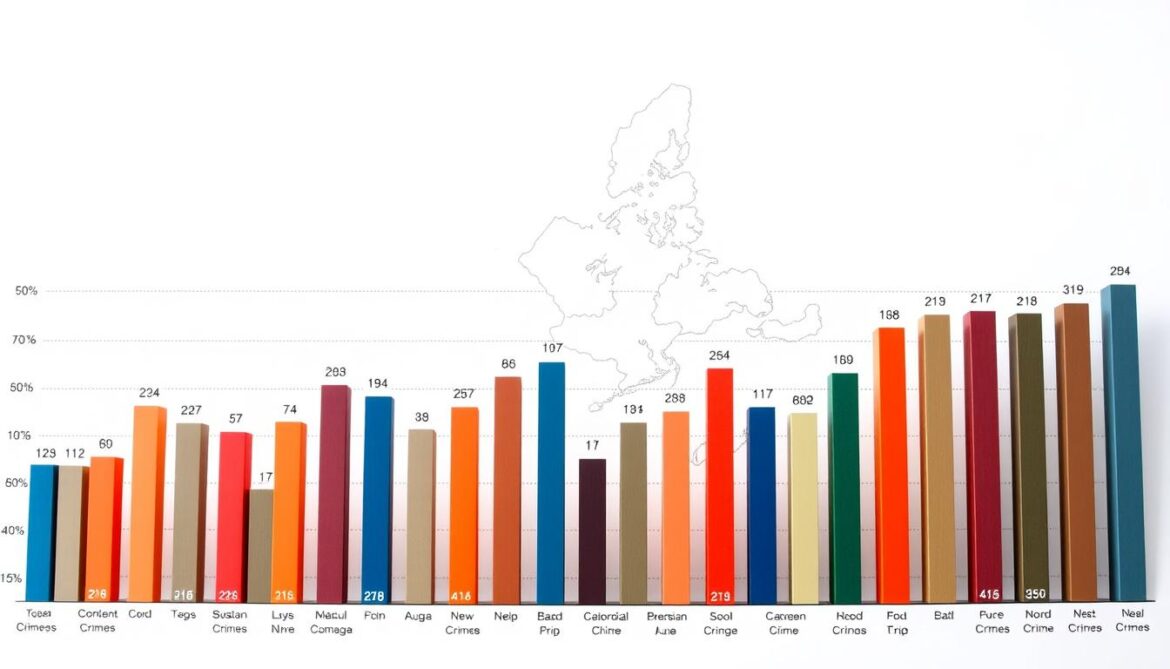In Canada, crime data plays a crucial role in shaping public safety policies and community awareness. Recent statistics reveal that British Columbia has seen fluctuations in its crime rate, sparking interest in the underlying causes and implications for residents.
The province relies on accurate data collection and reporting to inform police strategies and community programs. By examining crime trends and statistics, stakeholders can develop effective prevention initiatives. Understanding crime patterns is essential for fostering a safer environment across the region.
As we delve into the details of crime in British Columbia, it becomes clear that data transparency is vital for building trust between law enforcement and the communities they serve.
Understanding Crime Rates BC and Canadian Crime Statistics
To grasp the nuances of crime in British Columbia, it’s essential to examine the detailed crime information available through Statistics Canada. Crime data collection is a systematic process involving various law enforcement agencies across the province.
How Crime Data is Collected in British Columbia
Crime data in British Columbia is collected through a collaborative effort between local police departments, the Royal Canadian Mounted Police (RCMP), and other law enforcement agencies. These agencies report incidents to Statistics Canada, which then compiles and standardizes the data to ensure consistency and accuracy. The data collection process has evolved over time to improve accuracy and comprehensiveness in crime statistics.

The standardization process involves categorizing crimes according to the Canadian Criminal Code and other relevant legislation. This ensures that crime data from different regions is comparable, allowing for a more nuanced understanding of crime patterns across British Columbia.
Crime Severity Index and Its Significance
The Crime Severity Index (CSI) is a comprehensive measure that weights crimes according to their seriousness, providing a more detailed view than simple crime counts. The CSI is calculated based on the court sentences and societal impact of different offenses. This index is significant because it allows for a more accurate comparison of crime patterns across different regions and time periods in British Columbia.
For instance, according to the data from Statistics Canada 2023, the Crime Severity Index for British Columbia can be analyzed in detail. The following table illustrates the CSI and crime rates in BC:
| Year | Crime Severity Index | Crime Rate per 100,000 |
|---|---|---|
| 2020 | 114.45 | 5,634.56 |
| 2021 | 108.23 | 5,401.11 |
| 2022 | 104.56 | 5,234.78 |
This table demonstrates how the Crime Severity Index has changed over the years, providing insights into the trends and patterns of crime in British Columbia.
Current Crime Trends Across British Columbia
Crime statistics in British Columbia reveal a nuanced picture, with significant variations across different areas. The province’s diverse geography, population density, and economic factors all contribute to the complexity of its crime trends.
Recent data indicates that Metro Vancouver, with a population of 2,463,431, has a Crime Severity Index (CSI) of 90.2, representing a -2.4% change. The Violent Crime Severity Index stands at 79.3 (-7.4% change), while the Non-Violent Crime Severity Index is 95.4 (-0.6% change). In contrast, the city of Vancouver, with a population of 662,248, has a CSI of 97.0 (+5.6% change), a Violent Crime Severity Index of 102.8 (-2.8% change), and a Non-Violent Crime Severity Index of 95.5 (+9.6% change).
Regional District Crime Patterns
Regional variations in crime patterns are evident across British Columbia. Different districts, including Metro Vancouver, Vancouver Island, Northern BC, and the Interior regions, exhibit unique crime trends. For instance, areas with higher population densities tend to have different crime profiles compared to more rural areas.
| Region | Population | Crime Severity Index | Violent Crime Severity Index | Non-Violent Crime Severity Index |
|---|---|---|---|---|
| Metro Vancouver | 2,463,431 | 90.2 (-2.4%) | 79.3 (-7.4%) | 95.4 (-0.6%) |
| Vancouver | 662,248 | 97.0 (+5.6%) | 102.8 (-2.8%) | 95.5 (+9.6%) |
Metropolitan Areas vs. Rural Communities
The contrast between metropolitan areas like Vancouver and rural communities is striking. Metropolitan areas tend to have higher crime rates due to increased population density and socioeconomic factors. In contrast, rural communities often face challenges related to geographic isolation and limited access to resources, which can impact crime reporting and police response.

The analysis of crime trends across British Columbia highlights the need for tailored approaches to crime prevention and law enforcement. By understanding the unique characteristics of different regions and communities, policymakers and law enforcement agencies can develop more effective strategies to address crime.
The Canadian Criminal Code and Its Role in Crime Classification
Understanding the Canadian Criminal Code is essential for grasping how crime is categorized and reported in British Columbia. The Criminal Code serves as the legal foundation for defining criminal offenses across Canada, ensuring consistency in how crimes are classified and prosecuted.
Major Criminal Code Offences in BC
In British Columbia, the most prevalent Criminal Code offenses include property crimes, such as theft and break-and-enter, violent crimes like assault and homicide, and public order offenses. These categories are crucial for understanding the nature of crime in the province. According to the2022 BC Crime Statistics report, the data on these offenses provides insights into crime trends and patterns.
How Crimes Are Categorized and Reported
Crimes in BC are categorized for statistical purposes into violent and non-violent offenses. Violent crimes include offenses that involve physical harm or threat of harm to a person, while non-violent crimes typically involve property or public order offenses. The police agencies across the province follow standardized reporting procedures to ensure consistency in crime data. The “most serious offense” methodology is used in crime reporting, where the most severe offense is recorded in cases involving multiple crimes. This approach impacts the interpretation of crime statistics, as it prioritizes the most serious offense.
The categorization and reporting of crimes are closely tied to the definitions provided by the Canadian Criminal Code. Statistics Canada uses these definitions to categorize crimes for national reporting purposes. The relationship between the Criminal Code and Statistics Canada’s reporting categories helps clarify official crime statistics. For instance, changes to the Criminal Code over time can affect crime statistics, presenting challenges for year-over-year comparisons.

| Crime Category | Description | Examples |
|---|---|---|
| Violent Crimes | Offenses involving physical harm or threat of harm | Assault, Homicide |
| Property Crimes | Offenses involving property | Theft, Break-and-Enter |
| Public Order Offenses | Offenses that disturb public order | Mischief, Public Intoxication |
Detailed Crime Information Resources for BC Residents
The province of British Columbia provides its residents with a range of resources to stay informed about crime in their areas. These resources are crucial for understanding crime patterns, making informed decisions about personal safety, and contributing to community safety initiatives.
Official Statistics and Public Reporting Tools
Residents of BC can access official crime statistics through various public reporting tools. Statistics Canada databases and local police department reports are reliable sources of crime data. For instance, the GeoDASH Map is an interactive tool that allows users to visualize crime patterns in specific neighborhoods within Vancouver.
GeoDASH Stats provides detailed information on the types and frequency of crimes reported in Vancouver, enabling residents to understand crime trends and assess the safety of their local area.
Understanding Crime Maps and Data Visualization
Crime mapping technologies play a significant role in visualizing crime hotspots, trends, and patterns at both the city and neighborhood levels. By transforming complex crime statistics into accessible formats, data visualization tools help residents understand local safety concerns. The Crime Severity Index is another important tool that provides a standardized measure of crime severity, allowing for comparisons across different regions.
By leveraging these resources, BC residents can make informed decisions about their personal safety, property protection, and community engagement, ultimately contributing to safer communities.
Preventing Crime in British Columbia Communities
To create safer communities in British Columbia, it’s essential to adopt a comprehensive crime prevention strategy. Understanding localcrime statisticsand trends is vital for developing targeted initiatives that address specific community concerns. Thecrime severity indexprovides valuable insights into the level of crime in different areas, enabling law enforcement and local governments to allocate resources effectively.
Effective crime prevention involves collaboration betweenpolice services, local governments, businesses, and residents. By working together, communities can identify priority areas for intervention and implement evidence-based programs to reduce crime. For instance, community policing efforts have been successful in various BC municipalities, fostering a safer environment for residents.
It’s also important to address the root causes of crime, including social and economic factors. By understanding the underlying causes, communities can develop comprehensive prevention strategies that tackle the problem at its core. Year-over-yearchanges in crime statisticscan be used to evaluate the effectiveness of prevention initiatives and guide future resource allocation.
Residents can contribute to crime prevention efforts by staying informed about local safety conditions and participating in community initiatives. By working together, British Columbia communities can reduce crime rates and create a safer environment for everyone.

